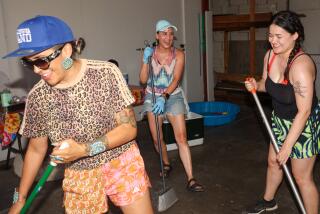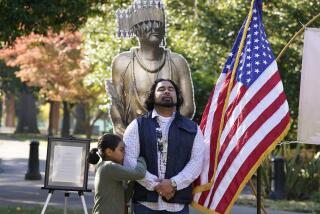No Offense Intended : Hands-on exhibition offers a factual, fun look at stateâs Native Americans.
Look beyond their âPocahontasâ Barbies (hairbrush included!) and plastic tomahawks, and youâll find that most kids today have a clearer view of Native American cultures than their parents did, April Morales says.
While preparing âThe First Californiansâ exhibit at the Childrenâs Museum at La Habra, show creator Morales studied local grade-school curricula and, she says, was generally pleased.
âI think the information is more accurately presented now than it was when I was a kid,â Morales, 34, said. âBack then, a lot of stuff was really glossed over. Now kids learn how history has treated the Indian people and that it hasnât been good to them.â
Although she stresses that the exhibit is apolitical, Morales hopes that âThe First Californiansâ will stimulate youngsters to learn even more about the trials and successes of the stateâs native people. To that end, she designed the hands-on exhibit to be both factual and fun.
âItâs a sensitive topic,â she admits, âand, frankly, you canât approach something like this without someone feeling offended. So you just do your best to correct the stereotypes and be sensitive to the issues.â
Few exhibits at this interactive childrenâs museum have used the galleryâs 1,000 square feet more effectively. In a recent 20-minute stop, two young visitors examined petroglyphs and dipped their fingers into a trickling waterfall in a cave of Styrofoam rocks; nestled inside a tule, or reed, hut; ducked inside a cedar roundhouse to try on grass skirts and breechcloths; and âhuntedâ for wild game with a bow and arrow (the arrows having been thoughtfully altered for safety).
All that, and they still had time to bag a couple of salmon and beg for âjust five more minutes, please.â
Californiaâs diverse environments once harbored more than 200 Native American cultural groups, speaking 65 different languages, Morales said. Southern California groups represented in this exhibit include the Chumash, the Tongva (also called the Gabrielino) and the Ajachmen (a.k.a. Juaneno).
Artifacts from these and other groups are sprinkled throughout the show, although some items, because of their age, monetary or spiritual value, are kept beyond childrenâs reach in cases or overhead. They include a battered but authentic log canoe and a variety of taxidermied animals typical of those hunted by California Indians. Also displayed is shell jewelry by Tongva artist L. Frank Manriquez and antique basketry and cooking implements lent by the Bowers Museum of Cultural art in Santa Ana.
A small but exquisite display by consultant Craig Torres, a Santa Ana resident who is descended from the Tongva and Chumash, explains the use of shells as jewelry and money. Torres, one of several local Native Americans who contributed information and displays for the show, also lent soapstone jewelry, musical instruments and dolls in Chumash dress.
There are plenty of hands-on opportunities. Children can grind corn with a stone mortar and pestle, weave with rabbit-skin strips, create rhythms with an elderberry wood clapper stick or spear salmon (painted sheet-metal versions fashioned by Moralesâ husband) using a stick topped with a hook.
Signage is kept to a minimum. There are, however, a few clippings that describe some of the bleaker periods in Californiaâs history of Native Americans, periods that Morales says shouldnât be overlooked, even in a childrenâs show.
âThe Indian people were here for thousands of yearsâ before Californiaâs settlement, she said. âThey had their own government and trade systems . . . a very developed culture. Within a short time, the first Spaniards came and enslaved them. . . . Then the Mission period and the Gold Rush all robbed them of their way of life.â
But Morales doesnât want to dwell on the bad times. Instead, she says, by recognizing the hardships Californiaâs native people have endured, exhibit visitors can better appreciate how vital it is to keep their traditions alive.
âThe point is, theyâve survived, and theyâre working hard to preserve the old ways,â she said. âThis is an opportunity to open some eyes to the reality of the past . . . and spark an interest for the future.â
BE THERE
âThe First Californiansâ continues through June 15 at the Childrenâs Museum at La Habra, 301 S. Euclid St. 10 a.m.-5 p.m. Monday-Saturday, 1-5 p.m. Sunday. $4; free for under age 2. (562) 905-9793.
More to Read
The biggest entertainment stories
Get our big stories about Hollywood, film, television, music, arts, culture and more right in your inbox as soon as they publish.
You may occasionally receive promotional content from the Los Angeles Times.










